The Secret to Raising Livestock for Cheap!
I want to share with you the secret to raising livestock for cheap! You may have heard a rumor that raising livestock is expensive (and it CAN be) or that homesteading is just as expensive as living in a city and buying groceries from a store.
That’s nonsense! It can also be done for not much money at all. Let me show you how we do it!
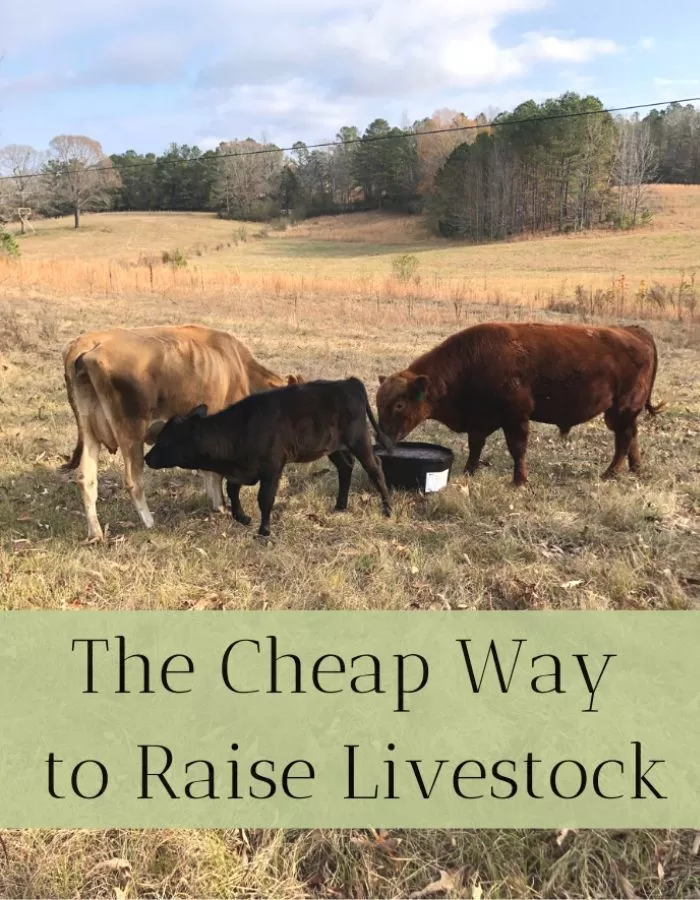
This post contains affiliate links, which means I make a small commission at no cost to you. Click here for my full disclosure.
First, let’s get this out of the way. Anything you do can be done cheaply or expensively. It can be simple or extravagant.
You can grow a tomato plant by starting a seed in an old pot with some dirt brought in from outside that you’ve put in the oven (to kill disease and weed seeds) and then transplanting the tomato plant outside when it’s a few weeks old. Or you can buy a tomato plant from a nursery, plant it in an expensive raised garden bed, and mulch it with expensive compost and bark mulch.
It’s the same way with livestock.
We learned some lessons and made some mistakes when we moved to the farm. I want to save you from making the same mistakes that we did!
Here’s the Secret to Raising Livestock for Cheap…Not Everything Needs to be Fed!
There are some animals that require their humans to provide them with food every day. Guardian livestock dogs, for example, need to be fed every day. But most of your livestock can survive and even thrive without you feeding them extra food that you had to purchase from outside and bring in.
Let’s start with the gateway livestock animal. Chickens.
The Secret to Raising Livestock for Cheap: Chickens Can Feed Themselves
Mistake #1: We bought a ton of chicken feed our first year on the farm.
We literally bought a ton (2,000 pounds) of chicken feed and it was delivered by a semi truck. The feed was $900 and the shipping was an extra $170.
The cost was hugely expensive but then we had trouble with storing it properly.
Then a local farm friend told us that he stopped feeding his free-range chickens years ago and never noticed a decline in egg production. Imagine that! It was a novel idea to us because of course our chickens would run to the food when we filled up their feeders. But then who doesn’t love a free meal, right?
Lesson Learned: Chickens can feed themselves when they are free.
Chickens forage for their own food and grit when they are free to roam around the yard. If you confine your chickens, you will need to feed them. That’s an extra cost and an extra chore for us. We decided we wanted to mimic nature as much as we could while also minimizing our costs.
Therefore, our chickens are completely free all the time. We did have some losses early on when we were training our guardian livestock dogs. But now they’ve learned that the chickens are supposed to be here. It’s been a long time since we had any losses and the dogs protect the chickens from predators now.
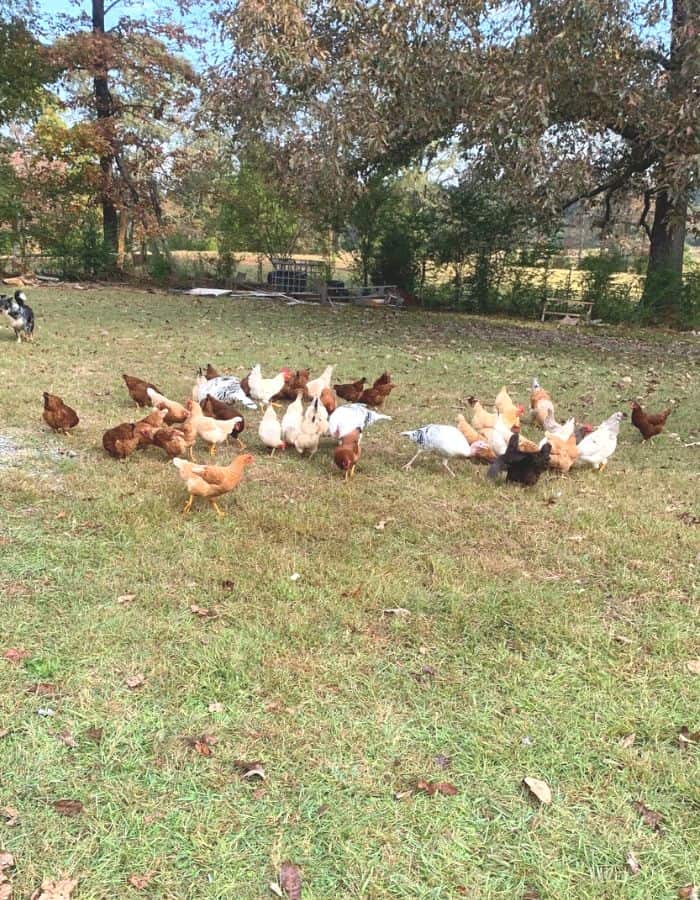
We stopped feeding our chickens and haven’t noticed a decline in egg production, either. Bonus: I haven’t seen any slugs, frogs, or grasshoppers where the chickens roam. That keeps our yard enjoyable. Also, as soon as we stopped feeding our chickens, the egg yolks became a darker orange and had more flavor!
Our model.
Our model is that our adolescent and grown chickens are free all the time. They have coops to go in at night to perch and sleep. They all go in their coops on their own when the sun starts going down and then they all leave their coops in the morning when the sun starts coming up. They’re never locked inside.
The eggs are laid in the same three places, so it’s not difficult for us to collect eggs every day. The chickens lay their eggs in nesting boxes at two coops and a separate group of chickens likes to lay their eggs at the barn on a bale of hay where they hang out. That works for us and the eggs are easy to collect.
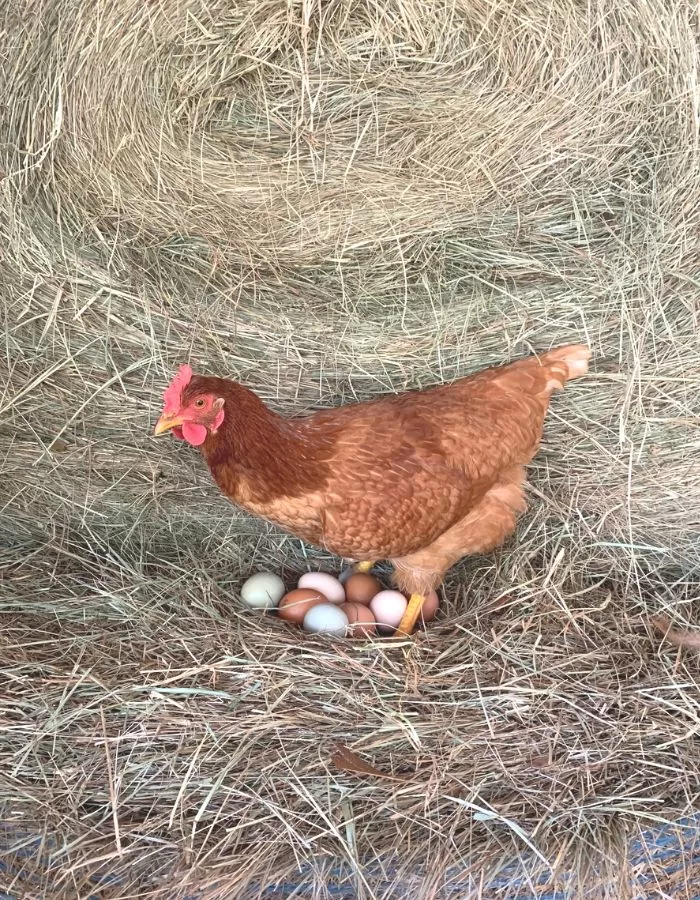
The only time we feed chickens is when they are babies and usually for just 3 to 4 weeks. We brood our baby chicks to keep them safe and warm. And because they’re confined, we feed them a chick starter. I bought two large bags of chick starter this year and we didn’t even use all of that for our baby chicks.
We don’t have harsh winters in central Alabama so there is usually plenty of food year-round for the chickens to find. However, we do like to throw some chicken scratch out occasionally during the winter. When they have access to crushed corn to eat, it keeps their bodies warmer for winter. If we get any snow, we will also feed them on those days.
But that’s it!
The Secret to Raising Livestock for Cheap: Heritage Turkeys Can Feed Themselves
When I say heritage turkeys, I mean sustainable or homestead turkeys that mate naturally, have longer lives, and can forage for their own food. Hybrid turkeys are modified to reach a larger size (broad breasted turkeys), they don’t mate naturally, they don’t forage well, and they only live long enough to reach harvest size.
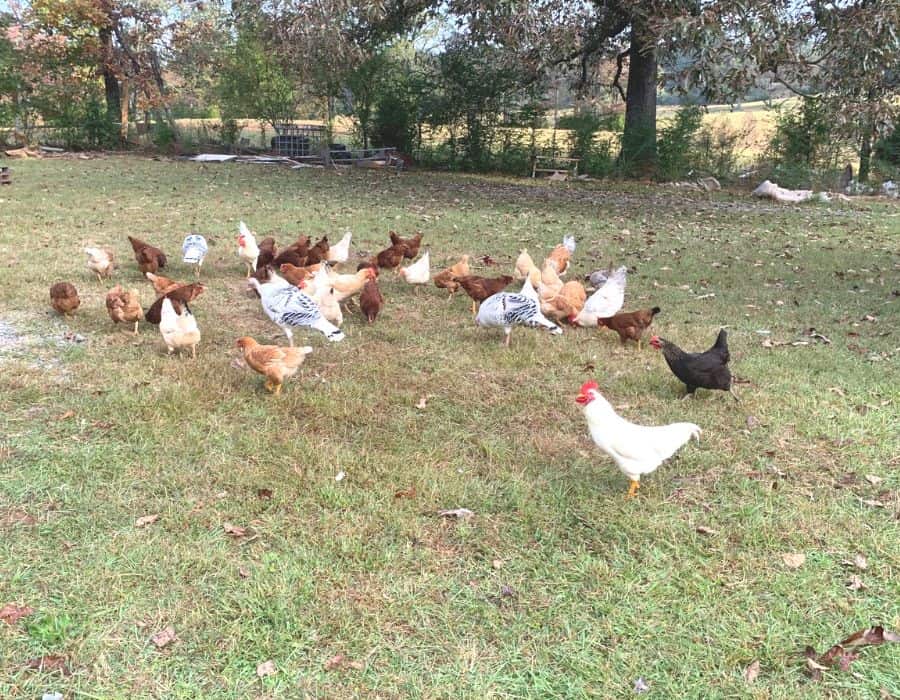
Heritage turkeys are just as easy as chickens for the most part. We brood our baby turkeys with our baby chicks and they all go out to pasture when they’re about the same age. They like to forage together. In the picture above, our three white and black heritage turkeys (Royal Palm) forage with the barn chickens.
Just as with the chickens, the only time we regularly feed the turkeys is when they are babies. They get a turkey starter, which is higher in protein than a chick starter. They will also occasionally get some crushed corn and scratch during the winter.
The Secret for Raising Livestock for Cheap: Goats Can Feed Themselves
Goats are probably the next easiest livestock because they eat all the woody shrubs and weeds. The short goats that we keep generally respect fences but I’m not sure that taller varieties would.
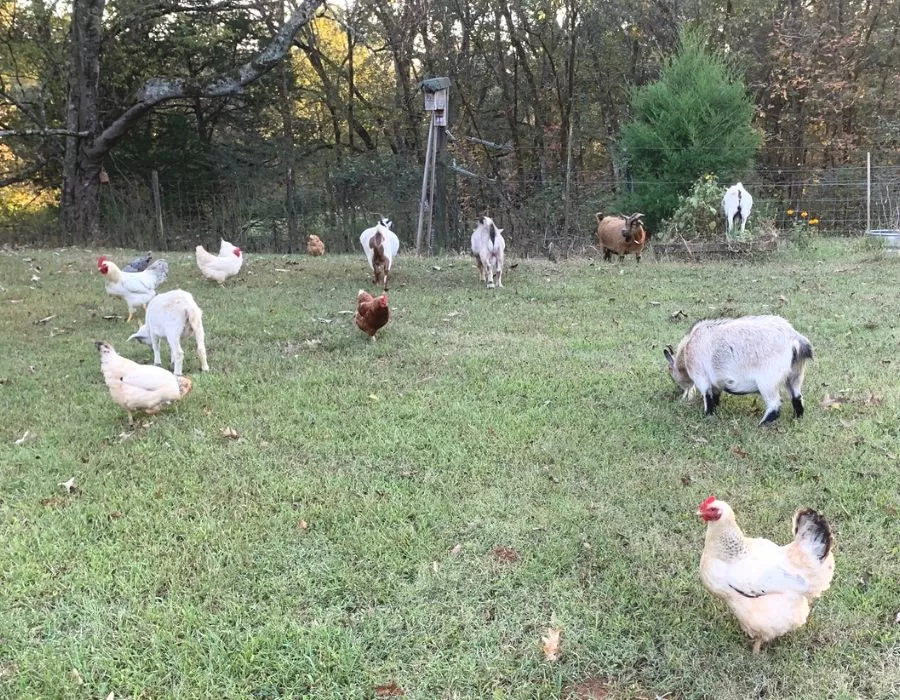
We initially got the goats to keep our woods cleaned out. The forest understory was starting to get some shrubby growth and the goats do a good job of eating them down.
Goats are also really good at keeping fence lines clear by eating the weeds that like to grow there. They feed themselves when there is enough grass and forage.
The only thing we have to buy for the goats is a loose mineral blend that includes copper. Copper is great for killing any internal parasites that might attack the goats.
We do occasionally give the goats some treats, but it’s not necessary for their survival.
The Secret to Raising Livestock for Cheap: Pigs Can Feed Themselves
We raised homestead pigs for 12 months. Those are smaller and more docile than traditional feeder pigs. We had two Kunekune pigs and an American Guinea Hog.
We kept our pigs in the woods by themselves but only the American Guinea hog stayed within the fencing. It’s really important that pigs stay away from smaller animals.
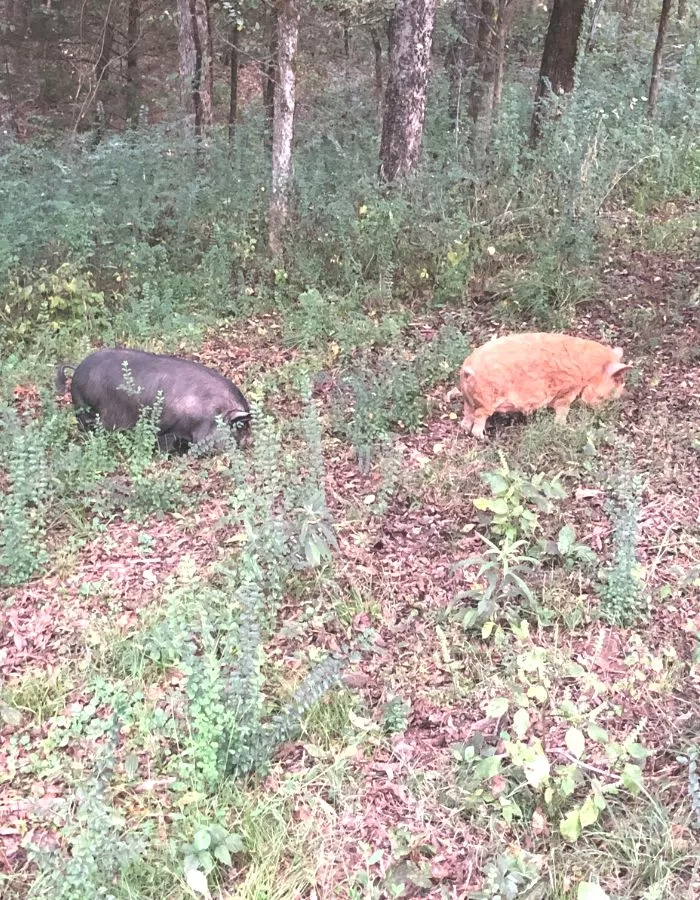
Mistake #2: We bought a ton of swine feed our first year.
We bought a ton (2,000 pounds) of swine feed for $820 and the shipping was an extra $170. We had the same issue of storage.
Then my sweet husband mentioned that wild hogs thrive in the woods without anyone feeding them. At least they do down here in the south.
From the time that we ran out of pig food, our pigs found their own food in the woods and kept growing at a normal pace. It’s surprising how much food animals can find on their own!
Pigs have a good sense of smell and a strong snout so they can find a lot of buried food on their own. They ate a lot of roots and a lot of shrubby growth.
Lesson Learned: Pigs can feed themselves.
The Secret to Raising Livestock for Cheap: Cows Can Feed Themselves
Everyone knows that cows eat grass and weeds and that wasn’t news to us. As long as you have plenty of grass for them to eat, they’ll be happy campers.
In the winter when grass goes dormant, we give our cows hay (dried grass). This is because when grass goes dormant, all the nutrients go down to the roots to keep the grass alive and there’s not much nutritional value left in the grass above the ground.
If you can cut your own hay in the summer, it won’t cost you anything but your labor to feed your cows in winter. You can also purchase some hay from local farms but be careful because you never know what you’re buying until you open it up and start going through it. We bought a couple of bad bales of hay last year from a local farmer and it was full of briers…not good quality hay at all. Now we cut our own hay and store it for winter.
We also have a loose mineral feeder in the cow pastures.
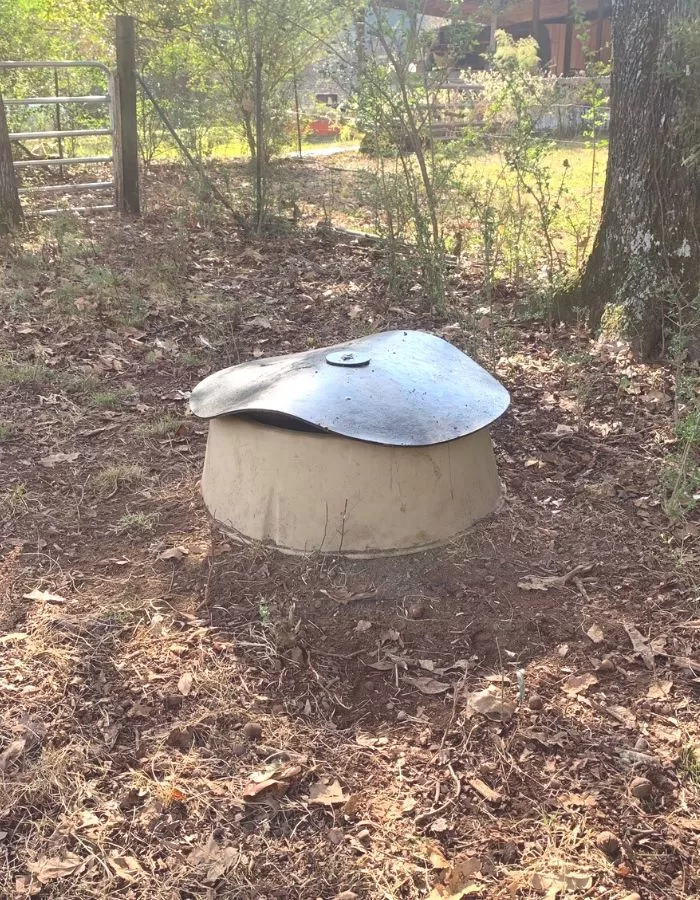
I like to provide agricultural grade Redmond Real Salt, Icelandic sea kelp, and a basic loose mineral in their feeder.
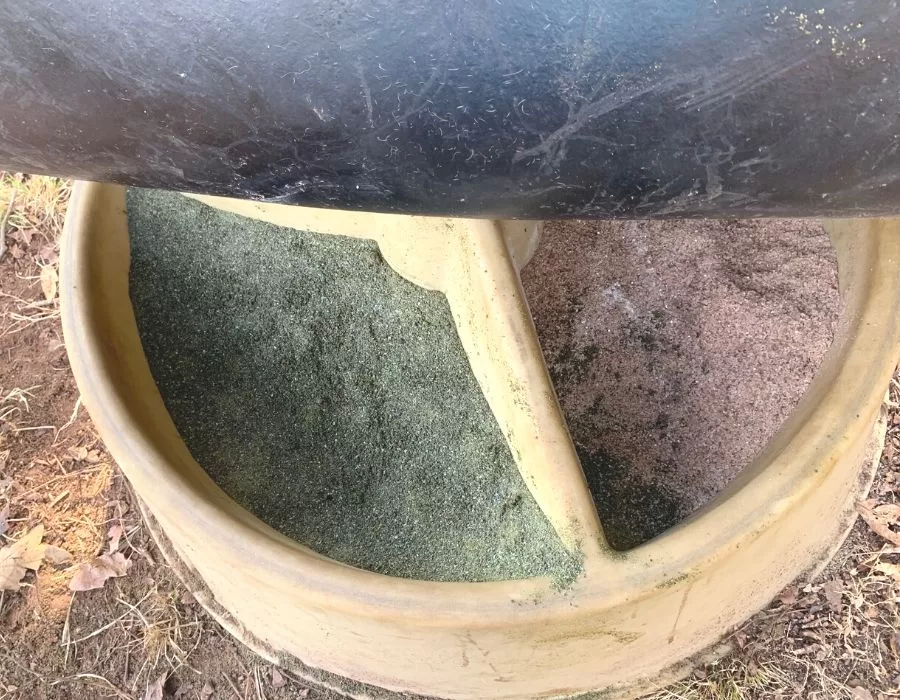
The amount of minerals your cows need will depend on the quality of the pasture they’re on. The more nutrients that are in the soil, the more nutrition the grass will have and the less minerals they will need to eat.
We also like to provide some extra protein during the winter months to supplement the hay they eat. We like using alfalfa pellets but the amount they need will vary from cow to cow. Bigger cows need more protein to maintain their body weight during winter.
The Bottom Line: The Secret to Raising Livestock for Cheap is to Stop Spending Money on Food!
You will need to spend money on minerals and possibly a bit of food for winter months, but stop wasting your time and energy on feeding your livestock when it’s not necessary.
If you want to learn how much beef you’ll get from a cow, read this blog post!
Shop This Post!
Redmond agricultural salt with selenium
Salad Bar Beef, by Joel Salatin
Other Posts You May Enjoy
How Much Beef Will You Get From a Cow: Breakdown
7 Tips for Emotions to Raise and Harvest Meat
Why Living in the Country is Cheaper
When is the Best Time to Order Baby Chicks?
Preparedness Tips to Save Money on Food
Homemade Vanilla Extract: 2 Liters for $35!
What are the Health Benefits of Bovine Colostrum?
Delicious Sausage and Liver Rice Recipe
Easiest Home Pregnancy Tests for Livestock
Pin It For Later!
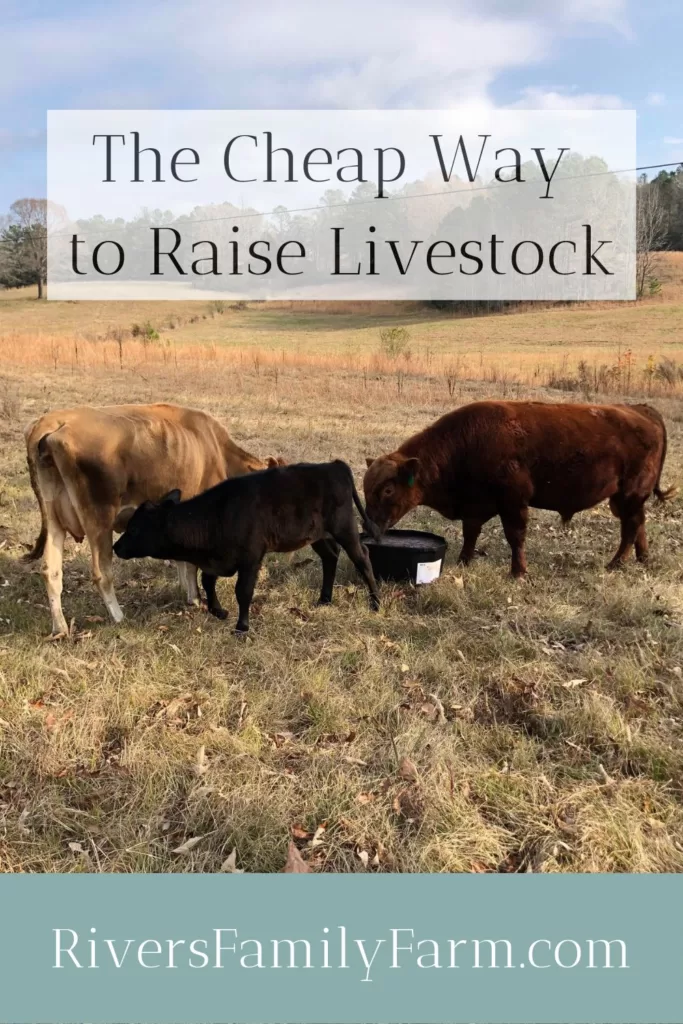

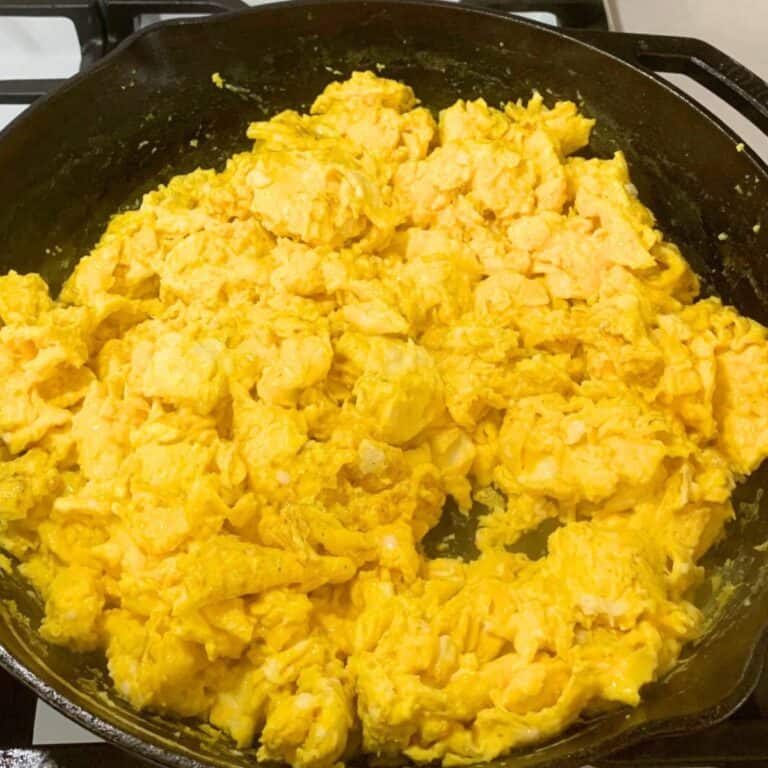
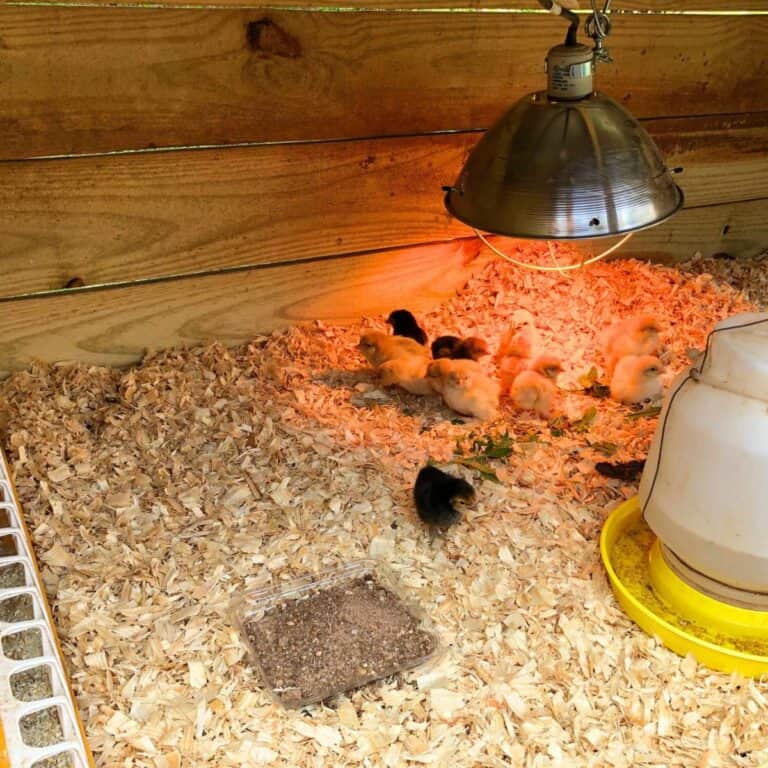
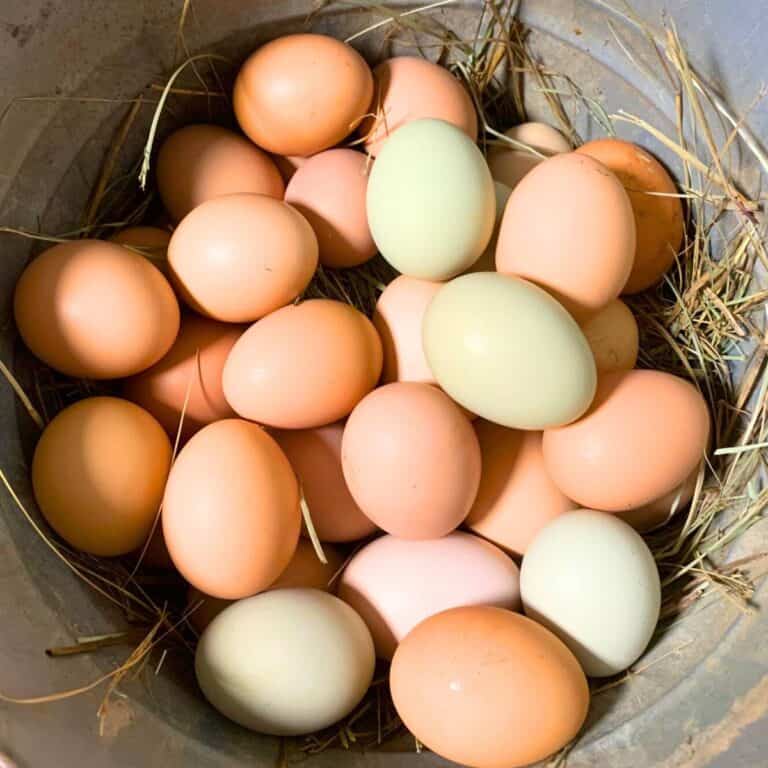
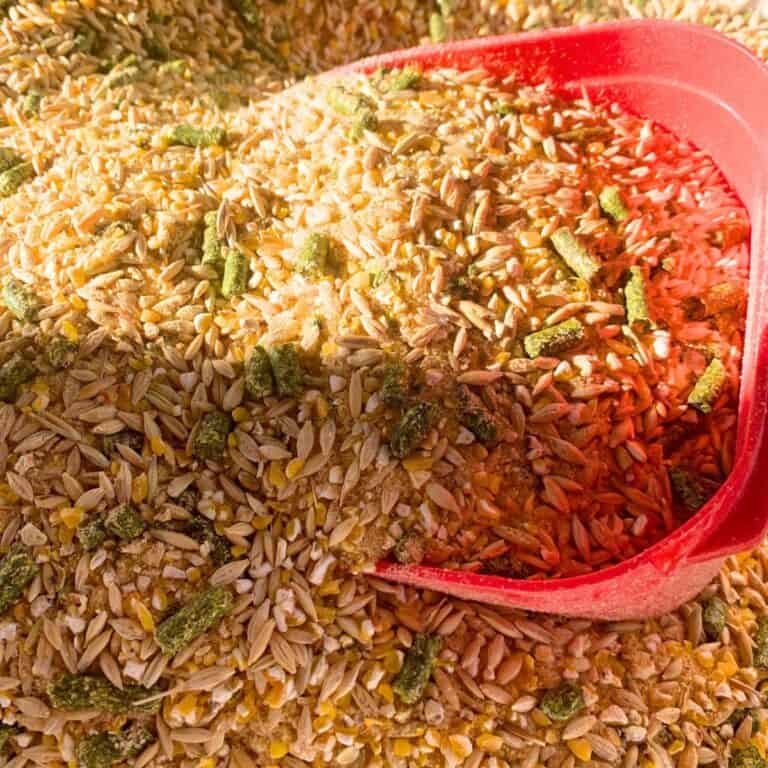
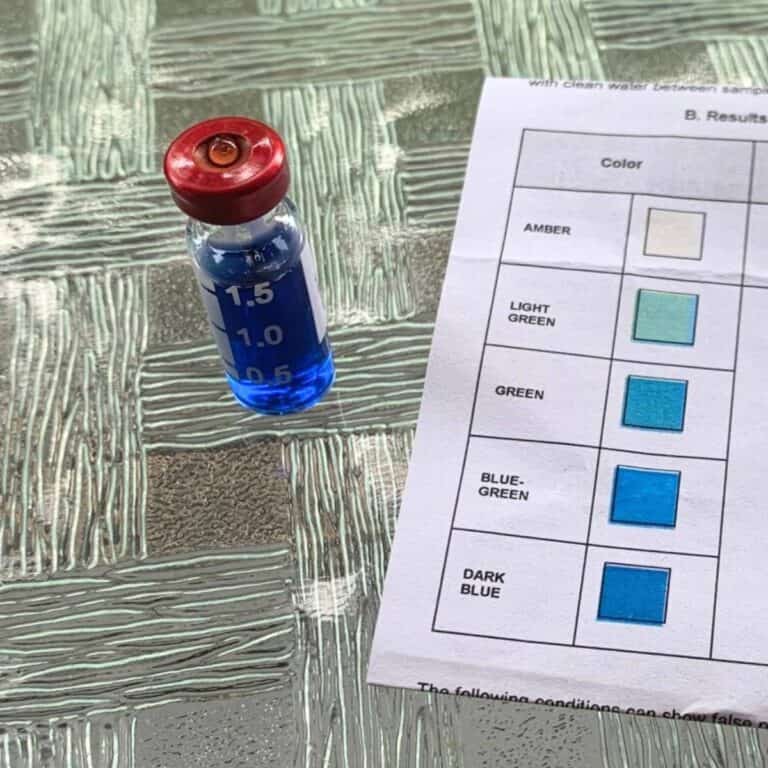
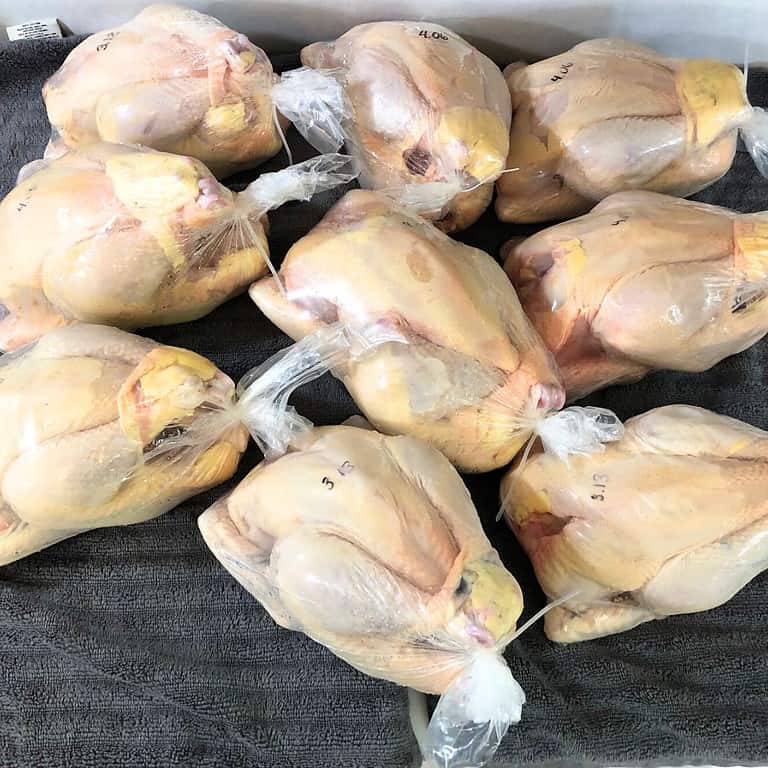
We’re praying about moving outside of the city and my wife brings up the idea of our chickens getting rid of pests, good to hear an anecdote of it working out. The place we’re looking at could possibly become a true homestead so I’m also happy to see your other tips if we do expand our ‘pet’ population
Such good information! We’re so excited about the possibilities of saving money on our animal feed.
I love this post! Now I wish we could have livestock!!!
Wow! This was really eye opening! We only have one acre, but I’m sure we could still make some changes. Thanks.
This was great! We have land and are trying to work out how to build on it in this crazy economy. If we can figure out a way to get a house built there won’t be as much left for all the other things as we had originally planned – so the thought of animals being able to feed themselves is a happy happy prospect!
Such great article and wonderful information!
We are hoping and praying that homesteading is in our hopefully not-so-distant future, so I am soaking up all the helpful tips and info I can find now! Thank you for sharing what you have learned! I will be saving this for the future! 🙂
Great Job!
Love hearing about how well the River’s Family Farm is doing. I feel very fortunate to have such an amazing resource of knowledge and experience when I finally begin my homesteading life.
Tell me more about the pigs. You said only the guinea hog stayed in the fencing. Did the kunekunes get out? Were they free ranged? A friend wants to sell me both her guinea hogs and kunekunes and I’m not sure which ones or both to get. What do you recommend? If they get out will they hurt the chickens? What kind of fencing is best? Ideally I’d like to fence about 10 acres but that’s probably too expensive. If I only did 2 acres should I do half pasture, half woods or more of one or the other? Wish you could come help me out!
Hi! I can tell you what our experience was with the pigs and what we would do differently in the future. We had fencing up for cows, so not really something made for pigs or that went very low to the ground and we didn’t electrify any of our fencing. That was our first misjudgment. When the pigs were small and still growing, all three would escape their fenced-in area on a daily basis but they didn’t go after any adult chickens. But eventually the guinea hog got too large to slip under the fence, so she was easy to contain and was generally happy with staying in our wooded area. The two kunekunes were a different story, though. They were smaller than the guinea hog by maybe 20 pounds and very persistent about slipping under the fence. They were so adorable, though. Just like puppies that couldn’t jump on you! And they kept wanting to be around us and to play with us or get some love. The beauty about keeping traditional homestead pigs is that they are slower growers and can feed themselves if they have enough room or are moved daily. I was so surprised that our pigs kept gaining weight even after we took their food away! To answer your question, we did feed our pigs every day in the beginning before we knew they could thrive without food. But once we figured that out, we did 100% free-range and they would only get kitchen scraps occasionally after the dogs and chickens got what they wanted. If I had to do it all over again, I would probably just go with guinea hogs because they’re easier to contain, still have great-tasting meat, and plenty of great lard. The taste of the meat was delicious for both the guinea hog and kunekune (we did a taste test with pork chops after harvesting our pigs) but the guinea hog flavor won by a small margin in my family. Also, the kunekune (known as a lard pig) had beautiful white fat that I rendered down into lard, but there was still plenty of fat on the guinea hog that I also rendered into lard. If you fence in 2 acres for pigs, I would run a hot wire across the bottom 12-18 inches from the ground to help contain your pigs and I would do either all woods or half pasture and half woods. If you’re in a hot climate, I would err on the side of keeping all 2 acres only in the woods (hot summers will be cooler for them plus the winter is warmer with the leaves). Our pigs didn’t really like pasture so much but when they were in the pasture, they would dig around a little bit and tear it up. If you want to make things easy on yourself, train the pigs to the hot line if/when you first get them. That way you can skip the permanent fencing altogether and just run a hot line in your woods! It will be mobile that way and you can contain them while also letting them get as much of their food as they want! Just be sure to move the fence at least every 10 days so pathogens (if any) won’t make them sick. I’m happy to help you have any other questions!!
How many acres do you have in total and how many acres do you chickens roam around? We have ducks. Currently they are confined in a run but we are going to let them free range a 1/2 acre when the fence is built.
Hi Bianca, I love that you want to let your ducks free range! To answer your question, we have 120 acres. That’s more land than we need, but the good news is you can do the same thing on a smaller scale on 1/2 acre, which is actually quite a lot. Our chickens roam free between our house and barn, which is probably around a 2-acre spread. Even though some wander farther, most stick close to home for protection by us and our livestock guardian dogs. I hope this helps!
Love, Rebekah